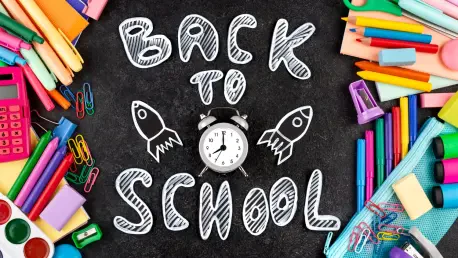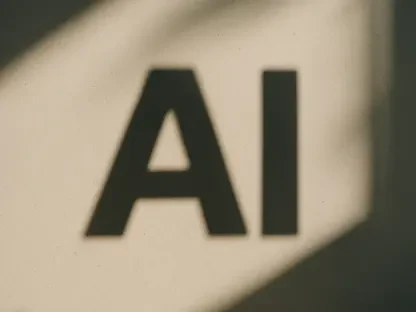In a bustling middle school classroom, a teacher juggles lesson planning, grading, and managing a room full of eager students—all while the clock ticks relentlessly toward the next bell, capturing the daily grind of teaching in 2025. What if technology could lighten this load, turning chaos into opportunity? Artificial intelligence is stepping into schools not as a distant dream but as a tangible ally, promising to reshape how education unfolds. This exploration dives into five groundbreaking AI tools that are redefining classroom dynamics, offering a glimpse into a smarter, more engaging school year.
Why AI Matters for Today’s Classrooms
The demands on educators have never been greater, with packed schedules and diverse student needs pulling focus from the heart of teaching. AI emerges as a critical tool, tackling repetitive tasks like drafting syllabi or organizing schedules, freeing up time for meaningful student interaction. A recent study revealed that teachers spend nearly 50% of their week on administrative duties—time that AI can significantly reduce. This shift isn’t just about efficiency; it’s about reigniting the passion for teaching by prioritizing human connection over paperwork.
Beyond time savings, AI holds the power to personalize learning, adapting to individual student paces and styles in ways traditional methods often can’t. Picture a struggling reader getting tailored exercises instantly or a curious mind exploring advanced topics through guided digital prompts. However, this potential comes with a caveat: technology must enhance, not replace, the critical thinking skills at the core of education. Striking this balance is the challenge and the promise of AI in schools today.
The Growing Impact of AI on Learning Environments
Classrooms are evolving into tech-savvy spaces where AI isn’t just an add-on but a fundamental component of daily routines. From 2025 to 2027, projections suggest a 30% increase in schools adopting AI solutions, driven by the need to manage larger class sizes and complex curricula. Tools powered by AI are already automating grading and providing real-time feedback, allowing educators to focus on mentoring rather than micromanaging. This trend reflects a broader shift toward tech integration as a necessity, not a luxury.
Yet, adoption isn’t without hurdles. Concerns about data privacy and the risk of students using AI to sidestep learning—like generating essays without effort—loom large. Educators must navigate these issues by setting firm guidelines and fostering digital literacy. The goal is clear: ensure AI serves as a scaffold for growth, supporting students in developing problem-solving skills while maintaining the integrity of the learning process.
Spotlight on Five Game-Changing AI Tools
Delving into specific solutions, five AI tools stand out for their ability to address distinct classroom challenges. Each offers a unique angle on enhancing education, from planning to engagement. ChatGPT acts as a virtual assistant, whipping up lesson outlines and parent communications in moments, though clear rules are needed to prevent misuse by students seeking quick homework fixes. A high school educator reported cutting planning time by 40% using this tool, a testament to its efficiency.
Next, ClassroomScreen transforms classroom management into a seamless digital experience, centralizing polls, timers, and even noise monitoring on one interface. It’s a lifeline for teachers wrangling energetic groups, ensuring focus stays on learning. Meanwhile, SchoolAI provides a safe space for students to ask questions and explore topics under teacher supervision, blending curiosity with accountability. This tool fosters inquiry without the risks of unchecked internet searches, making it a trusted companion for guided discovery.
Rounding out the list, Snorkl reimagines feedback through multimedia digital whiteboards where students can visually and verbally map out their thinking—think of a science project explained via sketches and voiceovers. Lastly, Suno brings creativity to the forefront by crafting educational songs, turning a history lesson into a memorable melody. These tools collectively illustrate AI’s versatility, catering to varied needs while sparking innovation in how knowledge is shared and absorbed.
Real Stories from Educators Embracing AI
Hearing from those on the front lines adds depth to the AI conversation. Jamie MacPherson, a Learning Specialist at a leading educational institute, emphasizes, “AI isn’t a shortcut; it’s a tool to amplify what teachers do best—ignite curiosity.” This sentiment echoes among many who’ve integrated tech into their routines. A 2025 survey by an edtech platform found that 78% of educators noted improved student participation after adopting AI, though nearly two-thirds expressed concern over potential over-dependence on digital aids.
Take Sarah Bennett, a middle school teacher, who saw tangible benefits with one of these tools. “Implementing a digital command center for my classroom slashed my morning prep by 20 minutes daily,” she shared. “That’s 20 minutes more to connect with my kids.” These firsthand accounts highlight AI’s dual role as both a time-saver and a catalyst for deeper engagement, while underscoring the need for mindful implementation to avoid pitfalls like diminished critical thinking.
Strategies for Seamlessly Adopting AI in Schools
Integrating AI into daily teaching doesn’t have to be daunting if approached with clear intent. Begin by selecting a single tool to streamline a specific task—perhaps using a content generator for weekly plans—and build familiarity before branching out. Setting a modest target, like automating one routine per month, can ease the transition without overwhelming staff or students. This gradual approach helps maintain control over the tech’s role in the classroom.
Equally important is establishing boundaries to uphold academic honesty. Rules should explicitly outline when and how AI can be used, ensuring it supports rather than substitutes effort. Pairing tools with active discussion also reinforces learning, turning tech into a springboard for dialogue. Additionally, tapping into creative platforms for projects—like composing a song about a math concept—can make lessons stick in unexpected ways. Regular reflection on AI’s impact, through student feedback or observed outcomes, ensures it remains a benefit, not a crutch, in the educational toolkit.
Reflecting on a Tech-Enhanced School Year
Looking back, the journey of weaving AI into classrooms during this school year revealed both its transformative power and the careful navigation it demanded. Teachers who embraced these tools often found themselves with more time to inspire, while students engaged with lessons in dynamic, memorable ways. The stories of streamlined days and sparked imaginations stood as proof of technology’s potential when harnessed with purpose.
Moving forward, the focus shifted to refining this integration—ensuring every educator had access to training and resources to wield AI effectively. Schools began prioritizing policies that balanced innovation with ethics, safeguarding learning’s core values. As the next academic term approached, the conversation turned to scaling these successes, exploring how AI could further personalize education while never losing sight of the human connection that defines teaching.









